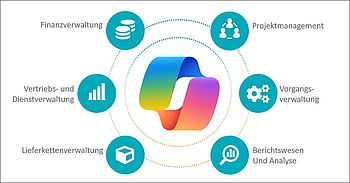Migration to the cloud: From Microsoft Dynamics NAV to Microsoft Dynamics 365 Business Central
Share:
The reasons in favor of the cloud are becoming more and more
Object security, reliability, redundancy, IT security, scalability, flexibility: the list of advantages of cloud solutions over on-premise is very long and has probably been known to everyone for a long time. In recent years, we have also written very often and in detail about the advantages of business solutions from the cloud.
- Advantages and disadvantages of cloud-based ERP systems
- A presentation of why solutions from the cloud are more secure,
- A brief summary: If you move your ERP system to the cloud, you have these advantages
In the last article, we described the migration from Microsoft Dynamics AX to Microsoft Dynamics 365. However, the added value that the cloud offers in this migration also applies to a migration from Microsoft Dynamics NAV to Microsoft Dynamics 365 Business Central.
AI for cloud users only
In addition to these “traditional advantages”, many providers of business solutions are currently making their AI solutions available first or exclusively to their cloud customers. Microsoft Copilot will not be available for Dynamics NAV, for example. If you stay on-premise, you will quickly miss the boat. Users of Business Central, on the other hand, are already benefiting from the many smart features of this AI solution. Read here for a brief insight into what Copilot in Business Central has to offer: AI functions through Copilot in Business Central
Why 2024 is the year to finally migrate to the cloud?
In addition, Microsoft has once again extended its “Bridge to the Cloud” promotion, which allows on-premise users to save up to 40% on cloud licenses. This discount on cloud licenses is valid for 3 years.
And best of all: the migration path from Dynamics NAV to Business Central (Essential or Premium) is explicitly supported in this promotion. We have described this argument in detail for you under the title “Why 2024 is the year to finally migrate to the cloud”. Here you will also find links to the “Bridge to the cloud 2” promotion, Microsoft's license model, the advantages of the cloud over on-premise and much more.
Migration has also long since become routine
As you can see, there are more and more reasons to use the cloud. While staying on-premise can increasingly become a risk, cloud users have long been in the fast lane thanks to AI and Copilot.
- But how exactly does an upgrade to the cloud from NAV to Business Central work?
- And is this migration not as complex as a small ERP project of your own?
We answer these questions in the second part of this article. You will see - there is a detailed roadmap for every migration to the cloud and even if no two ERP systems are exactly the same, this “migration project from NAV to BC” has long since become routine.
1. Analysis of the legacy system
Every NAV system is unique, as customizations, special processes and third-party extensions make each system individual. To ensure that your customizations are preserved when you move to the cloud, you need to work with your partner to analyze your system and prepare it for the upcoming update.
We usually start with a scoping workshop. Here we check, among other things:
- Which third-party add-ons you currently use and whether these are still required after a migration.
- Which interfaces you need and which need to be reprogrammed after the migration. However, there are often already ready-made connectors or the option of connecting systems via the Power Platform.
- Whether new technical functions will help to replace previous system adaptations and programming.
- Whether new functions can be used to make processes more efficient and target-oriented.
As you can see, there is always potential for savings. Our experience shows that many add-ons that are required in NAV are included in the standard version of Business Central and are no longer needed in the cloud. Of course, you can or should also use this workshop to request new things from your system.
2. Choose the migration path to the cloud
The migration of Microsoft Dynamics NAV to the cloud can take place via an upgrade, a restart or a combination of both. As this is an important decision that also forms the basis for the subsequent technical implementation, we will now take a closer look at these three options.
2.1 Upgrade
The main advantage of a classic upgrade is that all existing data and customizations are completely transferred from the old to the new system. Only the adaptations in the code need to be recreated and upgraded to the current technology. This keeps the necessary design effort relatively low. Customizations that are based on functions that are no longer supported are redesigned.
Conversely, however, this means that all the legacy data remains in the system. In particular, inconsistent databases that influence an upgrade must then be cleaned up. Optimization of functional processes is not part of an upgrade.
Once the decision has been made to upgrade, this usually takes place in several steps. According to the upgrade path from NAV to BC published here by Microsoft you either
- first update your current NAV version before switching to Business Central and upgrading to the latest version,
- or you upgrade directly from NAV to Business Central.
The more of these upgrade steps are required to get to Business Central (e.g. when using the NAV 2009 solution), the less economical the whole thing is and the more likely we are to recommend starting from scratch. In our opinion, a classic update only makes sense from Dynamics NAV 2015 and higher, as it can be completed in just a few steps. But of course, this is always a case-by-case decision that customers and partners make together.
2.2 Restart
This approach is similar to introducing a new ERP system. Your processes are revised and adapted to the current ERP standard. A restart is an excellent opportunity to eliminate old problems and inconsistencies in the system and to thoroughly “clean up” your system.
A restart is often chosen when the old system has too many customizations and legacy issues or the migration path is too long, as just described. This “clean restart” requires more detailed conceptual work than an upgrade. Nevertheless, it is worthwhile in most cases, as it can lead to a significant improvement in your processes.
Of course, you could also choose any competitor product to Microsoft for a reboot. As Business Central is very similar to the previous NAV solution in terms of procedures, processes, workflows, layout, etc., in our experience key users will find their way around the new system very quickly. Importing data from NAV to BC is also much easier. And if you were satisfied with NAV, you will love Business Central.
2.3 Combination
The combination brings together the best of both approaches. Data and applications are handled differently here:
- The data and data structures are almost completely transferred from NAV to BC.
- The applications, on the other hand, are converted to the new technology and re-implemented.
This approach also requires a very detailed analysis of databases and applications. Whether this approach can be implemented must be decided on a case-by-case basis.
All these preliminary considerations are part of the analysis phase at the beginning of the migration process to the cloud. Once you - together with your ERP partner - have found your optimal path, the technical implementation follows.
Migration to the cloud from NAV to BC - the implementation
The technical implementation consists of a series of in-depth analyses in which code and processes are examined in detail. Then the actual migration takes place. After the corresponding preparatory work in the legacy system, all data in the test system and productive system is migrated and adapted.
1. Analysis and realization
Like most ERP projects, an upgrade project is divided into these phases: Analysis, implementation, deployment and operation.
Depending on the chosen migration path, in-depth analyses of code and processes begin. The result is a list of all the technical tasks required for the migration. What exactly needs to be done varies greatly from project to project. Possible tasks could be
- Preliminary work in the legacy system (e.g. cleaning up inconsistent data)
- Migration of all necessary additions / add-ons from third-party providers
- Conception of necessary interfaces
Your ERP partner is responsible for these tasks. If you also have in-house users / developers with good Business Central knowledge (programming language AL), you are welcome to use them for support.
Once the preparatory work has been completed, a complete software solution is available that can manage the entire database of the old system. All your processes and workflows are set up in the new environment. As a rule, you are still working on a test environment at this stage.
2. Test phase and go-live
Once the preparatory work has been completed, the test phase follows. All users are given access to the test environment in order to test the processes comprehensively. Both the overall solution is tested and a go-live is simulated. A checklist records the test results and creates a schedule for the go-live, which usually takes place after a dress rehearsal with the current live database.
At some point, there simply comes a point where everything works. The old NAV system is shut down, databases are exported and transferred to Dynamics 365 Business Central. Now you have successfully arrived in the cloud.
Conclusion: Everything speaks in favor of migrating from NAV to BC
As shown in this blog post, there are currently - in 2024 - no real arguments against the cloud apart from a “vague feeling”. On the contrary, those who do not migrate now will be left behind by the competition. Because AI is getting better and better. Even if some test reports and personal experience still cast doubt on the quality: Used correctly, AI tools can help to increase efficiency and automate routine tasks. And more time means a head start.
In this blog post, we have also shown you that migration - at least from such large and frequently used systems as Microsoft Dynamics NAV to Microsoft Dynamics 365 Business Central - has long since become routine. At least for us.
And thanks to the “Bridge to the cloud 2” promotion directly from the manufacturer Microsoft itself, the financial incentive is also right. 40% discount on all cloud licenses for up to 3 years: it doesn't get any cheaper than this.
Your individual roadmap to the cloud
Do you want a customized roadmap for your migration to the cloud - from NAV to BC?
Then get in touch with us now.
We would be happy to meet you for an initial joint scoping workshop in which we analyze your system and your requirements in one day.
- We check the status quo (NAV environment, database, etc.),
- check your infrastructure (interfaces, extensions, etc.),
- analyze the efficiency of your system
- and also take a look at the financial aspects of migration to the cloud and compare the effort, costs, benefits and long-term advantages and opportunities for you.
You will receive concrete results, recommendations on how to proceed, licensing tips and a valid cost estimate from us on the very first day.
And best of all: under certain conditions, we also offer you this initial service free of charge. Simply use the contact form below to arrange an initial appointment without obligation.

![[Translate to English:] Migration in die Cloud - von NAV auf Business Central](/fileadmin/_processed_/6/0/csm_Titel-Migration-in-die-Cloud_ac9a16c2c3.jpg)


![[Translate to English:] Migration in die Cloud - von NAV auf BC [Translate to English:] Migration in die Cloud - von NAV auf BC](/fileadmin/_processed_/f/1/csm_Migration-in-die-Coud-Analyse-Altsystem_13b24b52ec.jpg)

![[Translate to English:] Migration in die Cloud - Umsetzung [Translate to English:] Migration in die Cloud - Umsetzung](/fileadmin/_processed_/9/5/csm_Migration-in-die-Cloud-NAV-auf-BC-Umsetzung_247f293a92.jpg)

